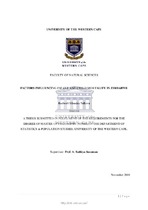| dc.description.abstract | According to a 2010 report by the United Nations, mortality rates among children under the age of five remain extremely high in most countries in sub-Saharan Africa in which Zimbabwe is one of them. Child mortality in Zimbabwe is found to be associated with the specific causes with differing factors. This thesis analyses main causes of child mortality in Zimbabwe with selected socioeconomic, bio-demographic, maternal fertility behaviour, sexual reproductive health and services delivery factors in the study area, and Zimbabwe’s progress towards reaching MDG 4&5, which is to improve maternal health and reduce child mortality.
The study used secondary data from the Demographic and Health Survey Zimbabwe of 2010-11, which is a nationally representative sample of all deaths based on household interviews to assess the impact of socioeconomic factors, health care accessibility and HIV/AIDS on infant and child mortality. This is a theoretical and descriptive study which uses odds and hazard rates of analysis and also used bio-demographic variables to understand the problem by exploring the data to obtain the most plausible estimates of infant and child mortality in the past decades.
The findings, to a great extent showed that, socioeconomic factors have a huge contribution to infant and child mortality rates in Zimbabwe. Preceding birth interval, family size, birth type, breastfeeding status, source of drinking water, mother education, mother income, area of residence, and father education have significant effect at univariate level, whereas, area of residence, mother education and father education were not significant at multivariate level.
The finding from the study revealed that mother’s educational level is not a determinant factor of infant and child mortality in Zimbabwe unlike other studies. However, awareness about the influencing factors of infant and child mortality is vital in order to control them, so also is enlightenment on the need of birth control and family size and benefit of breastfeeding. Improvement on the socioeconomic status and empowerment of citizens most especially women will help to reduce infant and child mortality. | en_US |

